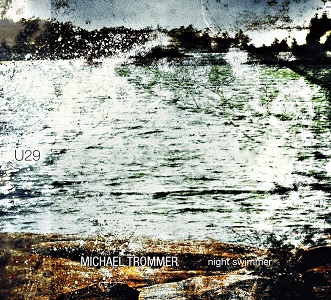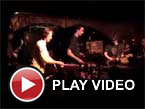Michael Trommer, "Night Swimmer"
 Like photographs, field recordings suggest unaltered reality. Suggests, not captures, because as in photography, there are artists who use field recordings for more than reproducing objective phenomena, if objectivity is even possible in the first place. Whether there’s an answer to that question, it at least points in the direction of impressionism and perspective, not just in visual productions, but in audible ones too. Whatever the medium, the artist brings more than a machine or a technique to the proceedings. Keeping with the comparison to photography, decisions about where to shoot and at what time, about exposure, and about dodging and burning all have parallels in field recording. They’re imprecise parallels, but they are clearly illustrated in the abstract shapes and bruised-blue colors of Michael Trommer’s Night Swimmer.
Like photographs, field recordings suggest unaltered reality. Suggests, not captures, because as in photography, there are artists who use field recordings for more than reproducing objective phenomena, if objectivity is even possible in the first place. Whether there’s an answer to that question, it at least points in the direction of impressionism and perspective, not just in visual productions, but in audible ones too. Whatever the medium, the artist brings more than a machine or a technique to the proceedings. Keeping with the comparison to photography, decisions about where to shoot and at what time, about exposure, and about dodging and burning all have parallels in field recording. They’re imprecise parallels, but they are clearly illustrated in the abstract shapes and bruised-blue colors of Michael Trommer’s Night Swimmer.
On his website, Michael Trommer describes himself as a sound artist focused on "psychogeographical explorations." Both halves of that psychogeographic descriptor are well evidenced on Night Swimmer, but the geographic component is worth sussing out first. Night Swimmer was recorded in 2013 at Southern Georgian Bay in Ontario, Canada, the 5,800 square mile bay of Lake Huron sometimes referred to as the sixth Great Lake. Home of the Anishinaabeg, Wendat, and Tionontati people, it is now also dotted with small Canadian cities and towns, like Lion’s Head, Owen Sound, and Wiarton, and is traversed by both commercial and private ships, including the MS Chi-Cheemaun, which connects the northern portion of Highway 6 with its southern portion. Due to the dramatic combination of exposed granite and tall white pines, and because one of its members owned land there, the Canadian Group of Seven often painted Georgian Bay, and today it attracts tourists interested in its beaches, islands, and pronounced peaks. Though far from isolated, had Trommer desired it, he could have represented the area in its state as a national park, not untouched by humans, but sometimes relieved of them.
Instead he opens the record with children playing in the water. One of them asks, "What am I going to do? Drift to shore?" To which another responds, with some excitement at the suggestion, "No, you’ll drift out to sea." Trommer continues to focus on the children for awhile. Other sounds both sharp and vague float by: the lapping of water against a boat, paper shuffling, Trommer’s breathing. Beneath these a deep, almost seismic tone rumbles, like the sound of music heard through a wall. Insects fade into the mix, then voices that seem to be artificially warped or time stretched, and then there’s a sudden electrical buzz, like a quick cut to a sizzling transformer, and the children disappear. All that’s left are the insects and that muddy, indistinct tone.
It resurfaces later on the same track as a pulsing bass figure and then again on "Night Swimmer 2D," where it becomes more or less obvious that Trommer is dunking his microphone into the bay. The resulting whir and thrum is both a kind of literal representation and a blurred image of the sounds above and below the surface of the water. It also brings an ominous mood to the music, especially as it is included in close proximity to electrical signals and sudden cuts for which there is little or no context. The lack of human sounds in the latter part of "Night Swimmer" further amplifies the stillness and enigma of the composition, and therefore of the surrounding area, and the deep, seemingly synthetic rhythms at the song’s conclusion serve as keen reminders of the breadth of the region. Where the expanse can’t be captured literally, Trommer recreates it poetically.
"Night Paddler" dives further into that stillness. The boats and voices discernible early on in the piece eventually recede into a cavernous space dominated by the echoing call of a solitary bird, a sound as beautiful and as lonely as any melodic figure you can name. After a short time, Michael inserts the sound of a popping flask lid. Water (or Canadian whiskey) can be heard rushing down his throat. There is no crackling fire, no indication whatsoever that this was all recorded at night, but it can be felt. The small sound of crickets, the odd rush of wind, the long, uninterrupted bird calls, they all scream blue and purple and silver light on black sky.
Trommer tips his hand at the end with "Night Swimmer 2D," a kind of pronounced re-imagining of everything before it, shot through with more noticeable post-production, loops, jump cuts, and denser sound fields. It casts some light on the techniques used throughout the album and it emphasizes the psychological half of Michael’s psychogeographic pursuit. Unable to see or hear or smell the places where these recordings take place, everything is transferred to an inner cinematic eye, which fills in the blanks and brings the personal to the purported solid ground of reality.
samples:
 



